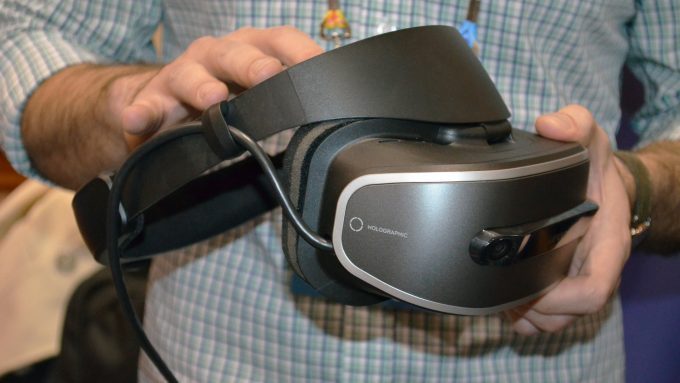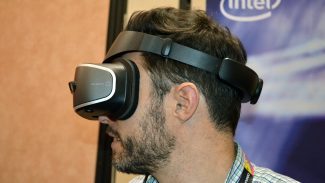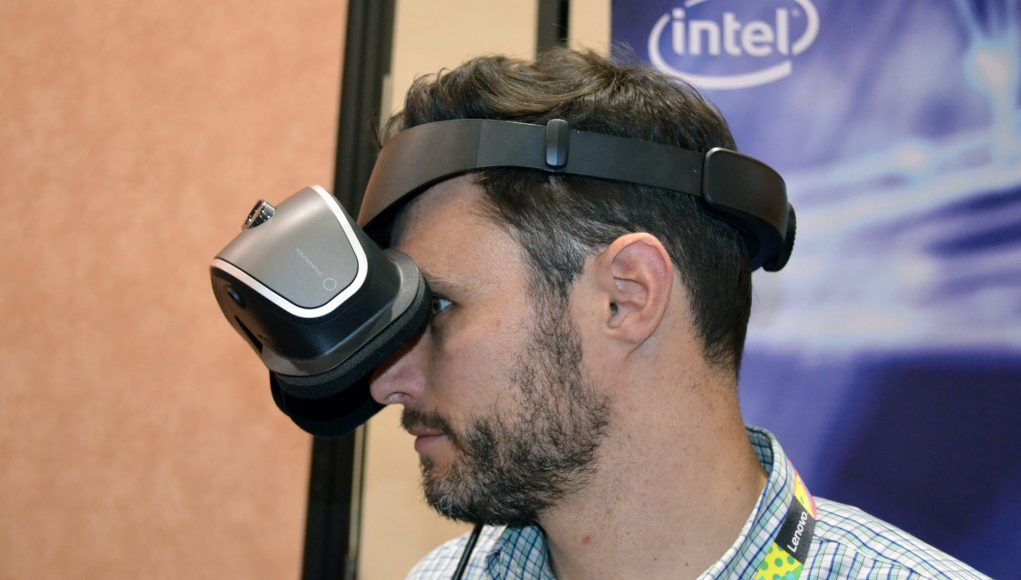We found out yesterday that Lenovo’s (still unnamed) VR headset is said to be surprisingly light and low cost, but after checking out the device ourselves, we found a hidden function that we wish was on every headset.
With the PSVR-like ‘halo’ head-mount of the Lenovo VR headset, the display enclosure hangs down from the forehead rather than being pressed against your face like a pair of ski goggles. Not only does that make it quite comfortable, but it also opens to door to a flip-up function that will make life wearing the headset much easier.
The Flip Factor
Putting on a headset only to realize you need to pick up a controller, find a pair of headphones, or answer your phone, is a pain. Sony’s PSVR has a retractable display enclosure which at least lets you peek out the bottom easily, but pointing your eyes downward at that angle gets uncomfortable after little more than a few seconds, and tilting your head (along with the heavy headset) up at an awkward angle to look at someone in the eye to talk them is no fun at all. The HTC Vive took at stab at the problem with a pass-through camera which lets you ‘see through’ the headset into the outside world, but the single-camera view lacks stereo depth (and is for some reason filtered with a silly stylized outline). In the end, the best solution to far to the ‘I need to look at something outside of my headset’ problem has simply been to remove the headset entirely.
As we got our hands on a design-prototype of Lenovo’s VR headset at CES this week, we found a handy feature that we hope to see replicated on headsets of the future: a simple hinge that allows the enclosure to easily flip up and down.
Design and Fit
The prototype we got our hands on was non-functional, but the industrial design appeared surprisingly mature. The rear of the headband had a ratcheting tightener (similar to PSVR) to make sure the headset fits snugly as it rests mostly atop your forehead, using the back of your head as an anchor. Compared to other headsets out there, the Lenovo VR headset was surprisingly small; closer to Gear VR in size than PSVR or Vive. The fit was comfortable, but as a non-functional prototype—that probably isn’t equal to the final weight—it’s hard to say how representative it is of the finished product. Generally, we’ve liked the ‘halo’ head-mount design, and hope Lenovo can make it as comfortable as the PSVR.
 Bring Your Own Audio
Bring Your Own Audio
Sadly, the headset uses the BYOA (bring your own audio) approach, rather than an integrated audio solution like the Rift. The wrong pair of headphones could compromise the headset’s comfort. Whichever pair you decide to use, you’ll have to connect them to a 3.5mm headphone jack that’s on the bottom of the display enclosure. That seems like a fairly awkward place for the connection, as it puts the dangling cord possibly in the way of your hands. On the Vive, the audio connection is found behind the head, while PSVR places it on a small junction box along the headset’s tether.
Cameras and Connections
Thanks to the two cameras on the front, the Lenovo VR headset has inside-out positional tracking (so you won’t have to set up external sensors), but the headset still needs to be powered and get data back and forth to the computer, which is why you’ll find an HDMI and USB plug at the end of the cable. So far it seems these will go directly into the computer without any sort of breakout box, but Lenovo has been tight lipped on details beyond showing us the design prototype, though they have let spill that the headset will use dual 1440×1440 displays, besting the present resolution of the Rift, Vive, and PSVR. It’s unclear if the front cameras will be used for anything beyond positional tracking (like pass-through vision or gesture input).
Lenses and (lack of) Adjustments
 Inside the display enclosure are two large lenses. We didn’t have a chance to inspect them up close—and for that matter the design-prototype may not have been using the final lenses that will end up in the headset—but they appeared to be non-Fresnel lenses, which (if final) means the headset won’t see the same sort of Fresnel-induced light ray artifacts as found in the Vive and Rift. Situated between the lenses we spied an infrared sensor which will detect when your head is or isn’t inside the device, allowing the screen to turn off and applications to pause when you pop the headset off (or flip the enclosure up).
Inside the display enclosure are two large lenses. We didn’t have a chance to inspect them up close—and for that matter the design-prototype may not have been using the final lenses that will end up in the headset—but they appeared to be non-Fresnel lenses, which (if final) means the headset won’t see the same sort of Fresnel-induced light ray artifacts as found in the Vive and Rift. Situated between the lenses we spied an infrared sensor which will detect when your head is or isn’t inside the device, allowing the screen to turn off and applications to pause when you pop the headset off (or flip the enclosure up).
Beyond the ratcheting mechanism on the back of the headband, we found no other adjustments on the headset (like lens separation or eye-relief). The compact enclosure means the Lenovo VR headset might have a challenge fitting glasses inside.
Lenovo hasn’t announced a release date for their VR headset yet, but have said it will be priced between $300 and $400. From what we’ve seen so far of the hardware, the headset is quite appealing, but the real test will come once we get to try out a functional version of the headset to see if the company has nailed the rest of it.







